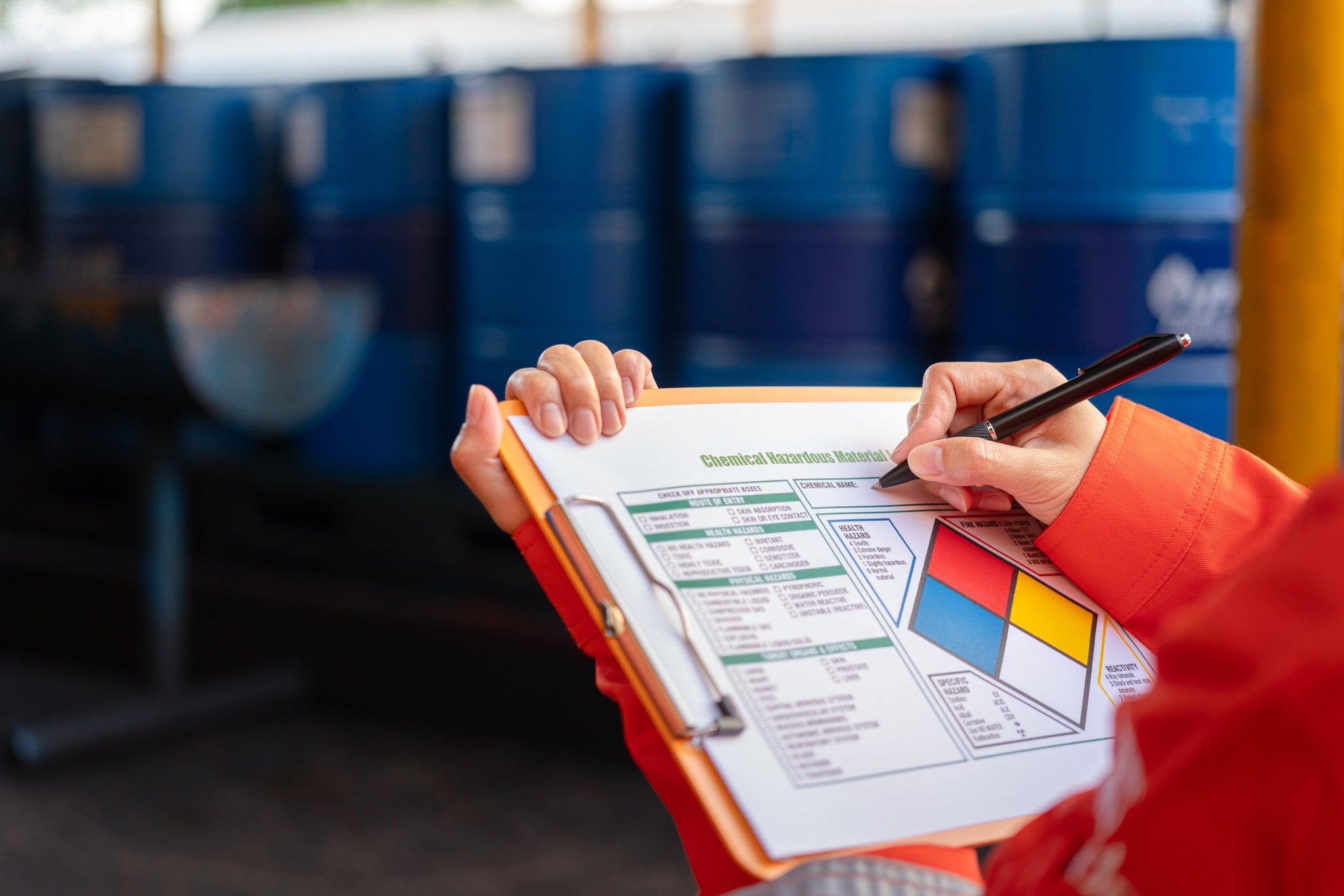All Articles

How to Store Witch Hazel
This guide outlines everything you need to know about how to store witch hazel effectively, from temperature and container selection to chemical compatibility and regulatory labeling.
This guide outlines everything you need to know about how to store witch hazel effectively, from temperature and container selection to chemical compatibility and regulatory labeling.

How to Safely Dispose of Witch Hazel
This article walks you through why proper disposal matters, outlines the correct disposal procedures for different settings, and provides safety tips to ensure responsible handling at every step.
This article walks you through why proper disposal matters, outlines the correct disposal procedures for different settings, and provides safety tips to ensure responsible handling at every step.

How and Why to Neutralize Witch Hazel
This guide explains why neutralization may be necessary, how to perform it correctly, and the best practices for safe and responsible handling in professional settings.
This guide explains why neutralization may be necessary, how to perform it correctly, and the best practices for safe and responsible handling in professional settings.

Witch Hazel Shelf Life & Expiration
This article explores how long witch hazel typically lasts, how to recognize when it has gone bad, and how to store it properly to extend its shelf life, starting with what affects witch hazel’s longevity and how to determine its true expiration window.
This article explores how long witch hazel typically lasts, how to recognize when it has gone bad, and how to store it properly to extend its shelf life, starting with what affects witch hazel’s longevity and how to determine its true expiration window.

Witch Hazel Safety & Hazards
Witch hazel is widely regarded as a gentle and natural skincare ingredient, frequently found in toners, medicated wipes, and over-the-counter ointments. While its soothing and anti-inflammatory benefits are well documented, it's still important to understand its chemical profile and safety considerations, especially when used in concentrated or alcohol-based forms.
Witch hazel is widely regarded as a gentle and natural skincare ingredient, frequently found in toners, medicated wipes, and over-the-counter ointments. While its soothing and anti-inflammatory benefits are well documented, it's still important to understand its chemical profile and safety considerations, especially when used in concentrated or alcohol-based forms.

How and Why to Neutralize Boric Acid
In this guide, we’ll explore when and why you should neutralize boric acid, and walk through step-by-step instructions on how to do it safely and effectively.
In this guide, we’ll explore when and why you should neutralize boric acid, and walk through step-by-step instructions on how to do it safely and effectively.

How to Store Boric Acid
Whether you manage a small container for home use or bulk supplies in an industrial setting, understanding how to store boric acid correctly helps preserve its quality, protect personnel, and maintain compliance with safety regulations.
Whether you manage a small container for home use or bulk supplies in an industrial setting, understanding how to store boric acid correctly helps preserve its quality, protect personnel, and maintain compliance with safety regulations.

Boric Acid Shelf Life & Expiration
In this guide, we’ll explore how to evaluate boric acid shelf life, recognize signs of degradation, and take steps to extend its usability through proper storage and handling.
In this guide, we’ll explore how to evaluate boric acid shelf life, recognize signs of degradation, and take steps to extend its usability through proper storage and handling.

Boric Acid Overview
In this guide, we’ll explore boric acid’s chemical profile, key applications, safety considerations, and how to source it in the appropriate grade and purity.
In this guide, we’ll explore boric acid’s chemical profile, key applications, safety considerations, and how to source it in the appropriate grade and purity.

How To Safely Dispose of Boric Acid
In this guide, we’ll walk you through why proper disposal matters, which methods are safest, and how to comply with disposal rules based on the type and quantity of boric acid involved.
In this guide, we’ll walk you through why proper disposal matters, which methods are safest, and how to comply with disposal rules based on the type and quantity of boric acid involved.

Boric Acid Safety & Hazards
Boric acid is widely used across industrial, agricultural, and consumer applications due to its versatility and relatively low toxicity at typical concentrations. But, is boric acid safe? Understanding it's risks is key to safe handling, regulatory compliance, and informed usage across all applications.
Boric acid is widely used across industrial, agricultural, and consumer applications due to its versatility and relatively low toxicity at typical concentrations. But, is boric acid safe? Understanding it's risks is key to safe handling, regulatory compliance, and informed usage across all applications.

Types of Boric Acid
In this guide, we’ll explore the different types of boric acid, how they’re classified, and how to select the most appropriate grade for your needs.
In this guide, we’ll explore the different types of boric acid, how they’re classified, and how to select the most appropriate grade for your needs.

Boric Acid Uses and Applications
Understanding how boric acid functions in different environments is key to using it effectively and safely. In this guide, we’ll walk through its most common and critical applications and outline sourcing recommendations.
Understanding how boric acid functions in different environments is key to using it effectively and safely. In this guide, we’ll walk through its most common and critical applications and outline sourcing recommendations.

Sodium Bicarbonate: Uses, Applications, and Industry Insights
Sodium bicarbonate (NaHCO₃), more commonly known as baking soda, is one of the most adaptable and widely used chemical compounds in the world. Whether it’s stabilizing a pharmaceutical formula or neutralizing acidic flue gas emissions, sodium bicarbonate’s chemical versatility makes it an essential ingredient across modern industry.
Sodium bicarbonate (NaHCO₃), more commonly known as baking soda, is one of the most adaptable and widely used chemical compounds in the world. Whether it’s stabilizing a pharmaceutical formula or neutralizing acidic flue gas emissions, sodium bicarbonate’s chemical versatility makes it an essential ingredient across modern industry.

How and Why to Use Sodium Bicarbonate for Neutralization
Sodium bicarbonate (NaHCO₃), commonly known as baking soda, is a trusted and widely used neutralizing agent. Because of its non-toxic nature, low reactivity, and affordability, sodium bicarbonate has become a go-to solution for managing acidity safely, without the hazards associated with stronger bases or more volatile neutralizers.
Sodium bicarbonate (NaHCO₃), commonly known as baking soda, is a trusted and widely used neutralizing agent. Because of its non-toxic nature, low reactivity, and affordability, sodium bicarbonate has become a go-to solution for managing acidity safely, without the hazards associated with stronger bases or more volatile neutralizers.

Sodium Bicarbonate Safety & Hazards
This guide provides an in-depth look at the potential hazards, exposure effects, emergency measures, and compliance standards associated with sodium bicarbonate use.
This guide provides an in-depth look at the potential hazards, exposure effects, emergency measures, and compliance standards associated with sodium bicarbonate use.

Shelf Life & Expiration of Sodium Bicarbonate
Sodium bicarbonate, or baking soda, is a reliable and widely used chemical. But over time it can lose its potency and functionality. Understanding its shelf life, how to identify expired product, and how to properly store and replace it is essential for maintaining safety, compliance, and product integrity.
Sodium bicarbonate, or baking soda, is a reliable and widely used chemical. But over time it can lose its potency and functionality. Understanding its shelf life, how to identify expired product, and how to properly store and replace it is essential for maintaining safety, compliance, and product integrity.

How to Store Hydrogen Peroxide Safely
Hydrogen peroxide is a widely used chemical, valued for its powerful oxidizing properties and clean decomposition into water and oxygen. However, its reactive and sometimes unstable nature - particularly at higher concentrations - makes proper storage a critical factor in ensuring both safety and product integrity.
Hydrogen peroxide is a widely used chemical, valued for its powerful oxidizing properties and clean decomposition into water and oxygen. However, its reactive and sometimes unstable nature - particularly at higher concentrations - makes proper storage a critical factor in ensuring both safety and product integrity.

How and Why to Neutralize Hydrogen Peroxide
Hydrogen peroxide (H₂O₂) is a powerful oxidizing agent used widely in industrial, laboratory, and healthcare settings. High concentrations pose serious risks, including chemical burns, fire hazards, and oxidative damage. Neutralizing hydrogen peroxide under controlled conditions is a crucial step for ensuring safety, protecting the environment, and meeting regulatory compliance standards - particularly when dealing with concentrated solutions or managing chemical spills.
Hydrogen peroxide (H₂O₂) is a powerful oxidizing agent used widely in industrial, laboratory, and healthcare settings. High concentrations pose serious risks, including chemical burns, fire hazards, and oxidative damage. Neutralizing hydrogen peroxide under controlled conditions is a crucial step for ensuring safety, protecting the environment, and meeting regulatory compliance standards - particularly when dealing with concentrated solutions or managing chemical spills.

Hydrogen Peroxide Overview
Hydrogen peroxide (H₂O₂) is an essential compound across industries, recognized for its powerful oxidizing action, environmentally safe byproducts, and broad-spectrum antimicrobial effects. Available in concentrations from 3% to 90% and in multiple certified grades, hydrogen peroxide is used everywhere from homes and hospitals to high-tech manufacturing and scientific research.
Hydrogen peroxide (H₂O₂) is an essential compound across industries, recognized for its powerful oxidizing action, environmentally safe byproducts, and broad-spectrum antimicrobial effects. Available in concentrations from 3% to 90% and in multiple certified grades, hydrogen peroxide is used everywhere from homes and hospitals to high-tech manufacturing and scientific research.

Expiration & Shelf Life of Hydrogen Peroxide
Hydrogen peroxide (H₂O₂) is a widely used chemical known for its effectiveness in disinfection, cleaning, bleaching, and oxidation. But while it may sit quietly in medicine cabinets or laboratory shelves, it doesn’t last forever. Understanding its shelf life, proper storage methods, and signs of degradation is essential for ensuring safety and effectiveness.
Hydrogen peroxide (H₂O₂) is a widely used chemical known for its effectiveness in disinfection, cleaning, bleaching, and oxidation. But while it may sit quietly in medicine cabinets or laboratory shelves, it doesn’t last forever. Understanding its shelf life, proper storage methods, and signs of degradation is essential for ensuring safety and effectiveness.

Hydrogen Peroxide Safety & Hazards
Hydrogen peroxide (H₂O₂) is a widely utilized oxidizer valued for its disinfecting, bleaching, and reactive properties. Despite its broad utility across various industries and everyday products, hydrogen peroxide poses significant hazards, particularly at higher concentrations. Proper safety protocols - including handling, storage, and emergency response - are essential to minimize risks.
Hydrogen peroxide (H₂O₂) is a widely utilized oxidizer valued for its disinfecting, bleaching, and reactive properties. Despite its broad utility across various industries and everyday products, hydrogen peroxide poses significant hazards, particularly at higher concentrations. Proper safety protocols - including handling, storage, and emergency response - are essential to minimize risks.

Hydrogen Peroxide Uses & Applications
Hydrogen peroxide (H₂O₂) is a highly effective oxidizing agent known for its exceptional versatility, clean decomposition into water and oxygen, and broad-spectrum antimicrobial properties. As a result, it has become indispensable in a wide array of sectors - from industrial processing and scientific laboratories to healthcare, agriculture, and everyday household uses. Its environmentally friendly profile makes it a preferred choice for organizations seeking sustainable chemical solutions.
Hydrogen peroxide (H₂O₂) is a highly effective oxidizing agent known for its exceptional versatility, clean decomposition into water and oxygen, and broad-spectrum antimicrobial properties. As a result, it has become indispensable in a wide array of sectors - from industrial processing and scientific laboratories to healthcare, agriculture, and everyday household uses. Its environmentally friendly profile makes it a preferred choice for organizations seeking sustainable chemical solutions.

Hydrogen Peroxide: Grades, Types & Purity Levels
Hydrogen peroxide (H₂O₂) is one of the most versatile and widely used chemicals in industrial, medical, and scientific fields. Understanding the distinctions between grades and choosing the right one for your specific application is essential to ensure safety, performance, and regulatory alignment.
Hydrogen peroxide (H₂O₂) is one of the most versatile and widely used chemicals in industrial, medical, and scientific fields. Understanding the distinctions between grades and choosing the right one for your specific application is essential to ensure safety, performance, and regulatory alignment.

Customer Stories
Real reviews from real customers.

Industries
Find chemicals for your industry.

Product Categories
Real reviews from real customers.

Product Specs
Product Specification Sheets for essential chemicals.

SDS
Printable chemical material Safety Data Sheet PDFs.

COA
Printable Certificates of Analysis in PDF format.
